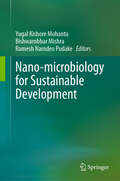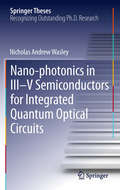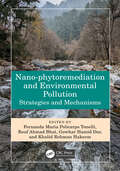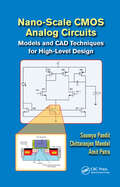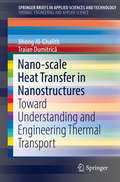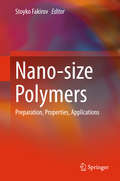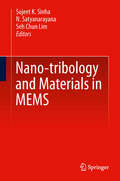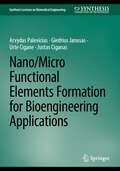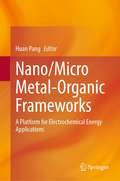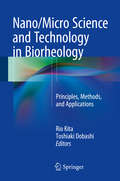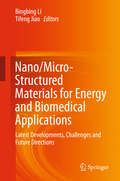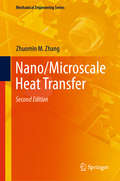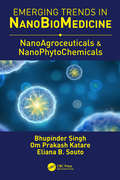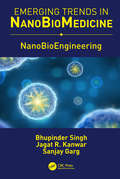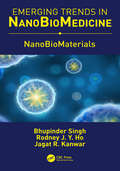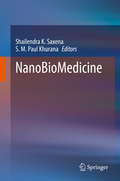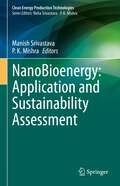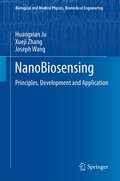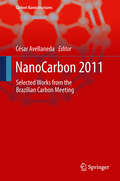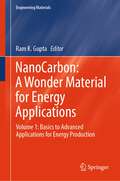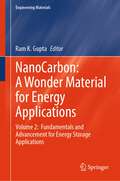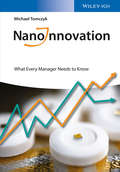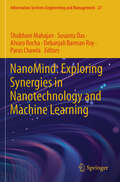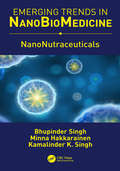- Table View
- List View
Nano-microbiology for Sustainable Development
by Ramesh Namdeo Pudake Yugal Kishore Mohanta Bishwambhar MishraMicrobial diversity and microbial technology are critical to achieving most of the UN Sustainable Development Goals (SDGs), mainly due to their central role in the provision and regulation of ecosystem services. Despite this intensification of effort, more than 90% of microbial diversity remains to be discovered. Thus, the most unique characteristic of microbial technology is the exceptional diversity of applications it can address and the range of human activities and needs to which it is and can be applied. Separately, nanotechnology and microbiology have produced innovative solutions for human well-being and ecological and environmental equilibrium. The development of interdisciplinary research practices combining nanotechnology and microbiology to deliver creative solutions for human health and environmental and ecological damage is urgently required. The nanotechnology of microorganisms is contributing to the development and innovation of numerous industries. This book will explain the fundamentals and methods of the biological production of nanoparticles from microorganisms, such as bacteria, fungi, and algae. It will describe optimization strategies for microbe-mediated nanoparticle production. The book will also discuss the industrial and agricultural applications of nanoparticles produced by microbes. It also describes the applications of green nanoparticles in the health and pharmaceutical sectors, such as the treatment of multidrug-resistant infections and cancer. Overall, the book focuses on the broad subject areas of microbial nanotechnology and its possible applications in food, pharmaceuticals, water, environmental remediation, etc. However, the lack of information and the potential for negative effects on the environment, human health, safety, and sustainability remain obstacles. This book addresses these issues. Researchers and students in the agricultural sciences, materials sciences, biotechnology, microbiology, and pharmaceutical sectors will find this an invaluable resource.
Nano-photonics in III-V Semiconductors for Integrated Quantum Optical Circuits
by Nicholas Andrew WasleyThis thesis breaks new ground in the physics of photonic circuits for quantum optical applications. The photonic circuits are based either on ridge waveguides or photonic crystals, with embedded quantum dots providing the single qubit, quantum optical emitters. The highlight of the thesis is the first demonstration of a spin-photon interface using an all-waveguide geometry, a vital component of a quantum optical circuit, based on deterministic single photon emission from a single quantum dot. The work makes a further important contribution to the field by demonstrating the effects and limitations that inevitable disorder places on photon propagation in photonic crystal waveguides, a further key component of quantum optical circuits. Overall the thesis offers a number of highly novel contributions to the field; those on chip circuits may prove to be the only means of scaling up the highly promising quantum-dot-based quantum information technology.
Nano-phytoremediation and Environmental Pollution: Strategies and Mechanisms
by Khalid Rehman Hakeem Rouf Ahmad Bhat Gowhar Hamid Dar Fernanda Maria Policarpo TonelliThe book discusses nano-phytoremediation: the use of nanotechnology in combination with phytoremediation to restore polluted environs. The potentiality of plants in association with nanomaterials to effectively remediate polluted areas is elaborated meritoriously in this book. New strategies are necessary because anthropogenic actions represent a serious threat to life on Earth. This book has given enough space for a discussion of innovative and efficient technologies to restore damaged environs primarily focused on nano-phytoremediation. The first part of the book is dedicated to exploring organic and inorganic pollution and the threats they pose to living forms. The second part explores the joint use of plants and nanomaterials and the nano-phytoremediation of water and soil ecosystems. The book offers readers extensive knowledge on nano-phytoremediation as a feasible strategy to clean environmental pollution. The key features of the book are as follows: Nano-phytoremediation strategies to remediate soil and water ecosystems. Special chapters dedicated to different kinds of pollutants and methods of phytoremediation. Strategies to evaluate the success of nano-phytoremediation strategies, cost-effectiveness, and nano informatics to safe nanotechnology. The book can be used as a primary or supplementary text in undergraduate, graduate, and post-graduate courses such as biotechnology, biochemistry, and environmental engineering. It is an interesting edition for instructors, researchers, and scientists working on environmental management and pollution control.
Nano-scale CMOS Analog Circuits: Models and CAD Techniques for High-Level Design
by Soumya Pandit Chittaranjan Mandal Amit PatraReliability concerns and the limitations of process technology can sometimes restrict the innovation process involved in designing nano-scale analog circuits. The success of nano-scale analog circuit design requires repeat experimentation, correct analysis of the device physics, process technology, and adequate use of the knowledge database. Starting with the basics, Nano-Scale CMOS Analog Circuits: Models and CAD Techniques for High-Level Design introduces the essential fundamental concepts for designing analog circuits with optimal performances. This book explains the links between the physics and technology of scaled MOS transistors and the design and simulation of nano-scale analog circuits. It also explores the development of structured computer-aided design (CAD) techniques for architecture-level and circuit-level design of analog circuits. The book outlines the general trends of technology scaling with respect to device geometry, process parameters, and supply voltage. It describes models and optimization techniques, as well as the compact modeling of scaled MOS transistors for VLSI circuit simulation. • Includes two learning-based methods: the artificial neural network (ANN) and the least-squares support vector machine (LS-SVM) method • Provides case studies demonstrating the practical use of these two methods • Explores circuit sizing and specification translation tasks • Introduces the particle swarm optimization technique and provides examples of sizing analog circuits • Discusses the advanced effects of scaled MOS transistors like narrow width effects, and vertical and lateral channel engineering Nano-Scale CMOS Analog Circuits: Models and CAD Techniques for High-Level Design describes the models and CAD techniques, explores the physics of MOS transistors, and considers the design challenges involving statistical variations of process technology parameters and reliability constraints related to circuit design.
Nano-scale Heat Transfer in Nanostructures: Toward Understanding And Engineering Thermal Transport (SpringerBriefs in Applied Sciences and Technology)
by Jihong Al-Ghalith Traian DumitricăThe book introduces modern atomistic techniques for predicting heat transfer in nanostructures, and discusses the applications of these techniques on three modern topics. The study of heat transport in screw-dislocated nanowires with low thermal conductivity in their bulk form represents the knowledge base needed for engineering thermal transport in advanced thermoelectric and electronic materials, and suggests a new route to lower thermal conductivity that could promote thermoelectricity. The study of high-temperature coating composite materials facilitates the understanding of the role played by composition and structural characterization, which is difficult to approach via experiments. And the understanding of the impact of deformations, such as bending and collapsing on thermal transport along carbon nanotubes, is important as carbon nanotubes, due to their exceptional thermal and mechanical properties, are excellent material candidates in a variety of applications, including thermal interface materials, thermal switches and composite materials.
Nano-size Polymers
by Stoyko FakirovThis book details all current techniques for converting bulk polymers into nano-size materials. The authors highlight various physical and chemical approaches for preparation of nano-size polymers. They describe the properties of these materials and their extensive potential commercial applications.
Nano-tribology and Materials in MEMS
by N. Satyanarayana Seh Chun Lim Sujeet K. SinhaThis book brings together recent developments in the areas of MEMS tribology, novel lubricants and coatings for nanotechnological applications, biomimetics in tribology and fundamentals of micro/nano-tribology. Tribology plays important roles in the functioning and durability of machines at small length scales because of the problems associated with strong surface adhesion, friction, wear etc. Recently, a number of studies have been conducted to understand tribological phenomena at nano/micro scales and many new tribological solutions for MEMS have been proposed.
Nano/Micro Functional Elements Formation for Bioengineering Applications (Synthesis Lectures on Biomedical Engineering)
by Giedrius Janusas Arvydas Palevicius Urte Cigane Justas CiganasIn recent years, various technologies dedicated to the formation of micro- and nanostructures have been intensively developed. Microstructures and nanostructures are manufactured from various materials with different parameters in a wide range of industrial sectors. These structures are used in devices such as biosensors, optical devices, microfluidic devices, electronic components, fluid mixing devices, particle separation or mixing devices, and single-molecule analysis devices. In this book technologies are being developed for the formation of nano/micro structures that allow the creation of new types of functional elements used in bioengineering. A magnetostrictive converter was developed and studied for the formation of microstructures in polymers, and a newly developed technology using mechanical vibrations during the chemical process was used to form aluminum nanopores. The synergy of these two technologies ensures the creation of a new type of functional elements used in bioengineering. It is presented how to replace the piezoelectric transducer with a magnetostrictive transducer in order to improve hot embossing technology for formation microstructures in polymers. The improved transducer would not only allow for the formation of structures at higher temperatures but would also eliminate the need for an additional heating element which generates a significant amount of heat during the process, thus optimising the device. The important aspects of this system include determining the working parameters of the structure formation which affect the quality and reproducibility of the structures. Research related to nanostructured nanoporous membranes has been receiving a lot of attention from scientists and businesspeople, which is why it is important to develop technologies and deepen knowledge about the chemical and physical processes that take place during fabrication to solve the challenges related to nanostructured membranes. Having it in mind this book presents a novel fabrication technology of nanoporous AAO membranes using vibrations, including production processes, their parameters, and a description of the properties of the fabricated membranes. Moreover, the book presents a technology for replicating the geometry of the AAO membrane in a biocompatible chitosan membrane, when nanopillars are formed on the surface of the chitosan membrane. It also presents the relationships and interactions studied between various parameters, which is achieved by presenting sets of experimental results. Combining these technologies the manufacturing of functional elements and their application to bioengineering. The book will be useful for researchers not only in Mechanical Engineering but also for Material Science and Chemical Engineering. It could be used for master and Ph.D. students too.
Nano/Micro Metal-Organic Frameworks: A Platform for Electrochemical Energy Applications
by Huan PangThis book systematically describes the design and synthesis of MOF-related materials and the electrochemical energy storage-related research in the field of batteries. It starts with an introduction to the synthesis of MOF-based materials and various MOF derivatives, such as MOF-derived porous carbon and MOF-derived metal nanoparticles. This is followed by highlighting the interesting examples for electrochemical applications, illustrating recent advances in battery, supercapacitor, and water splitting. This book is interesting and useful to a wide readership in the various fields of chemical science, materials science, and engineering.
Nano/Micro Science and Technology in Biorheology
by Rio Kita Toshiaki DobashiIntegrating basic to applied science and technology in medicine, pharmaceutics, molecular biology, biomedical engineering, biophysics and irreversible thermodynamics, this book covers cutting-edge research of the structure and function of biomaterials at a molecular level. In addition, it examines for the first time studies performed at the nano- and micro scale. With innovative technologies and methodologies aiming to clarify the molecular mechanism and macroscopic relationship, Nano/Micro Science and Technology in Biorheology thoroughly covers the basic principles of these studies, with helpful step-by-step explanations of methodologies and insight into medical applications. Written by pioneering researchers, the book is a valuable resource for academics and industry scientists, as well as graduate students, working or studying in bio-related fields.
Nano/Micro-Structured Materials for Energy and Biomedical Applications
by Bingbing Li Tifeng JiaoThis book discusses the latest developments of the synthesis, preparation, characterization, and applications of nano/microstructure-based materials in biomedical and energetic fields. It introduces several popular approaches to fabricating these materials, including template-assisted fabrication, electrospinning of organic/inorganic hybrid materials, biomineralization-mediated self-assembly, etc. The latest results in material evaluation for targeted applications are also presented. In particular, the book highlights the latest advances and future challenges in polymer nanodielectrics for energy storage applications. As such, it offers a valuable reference guide for scholars interested in the synthesis and evaluation of nano/microstructure-based materials, as well as their biomedical and energetic applications. It also provides essential insights for graduate students and scientists pursuing research in the broad fields of composite materials, polymers, organic/inorganic hybrid materials, nano-assembly, etc.
Nano/Microscale Heat Transfer (Mechanical Engineering Series)
by Zhuomin M. ZhangThis substantially updated and augmented second edition adds over 200 pages of text covering and an array of newer developments in nanoscale thermal transport. In Nano/Microscale Heat Transfer, 2nd edition, Dr. Zhang expands his classroom-proven text to incorporate thermal conductivity spectroscopy, time-domain and frequency-domain thermoreflectance techniques, quantum size effect on specific heat, coherent phonon, minimum thermal conductivity, interface thermal conductance, thermal interface materials, 2D sheet materials and their unique thermal properties, soft materials, first-principles simulation, hyperbolic metamaterials, magnetic polaritons, and new near-field radiation experiments and numerical simulations. Informed by over 12 years use, the author’s research experience, and feedback from teaching faculty, the book has been reorganized in many sections and enriched with more examples and homework problems. Solutions for selected problems are also available to qualified faculty via a password-protected website.• Substantially updates and augments the widely adopted original edition, adding over 200 pages and many new illustrations;• Incorporates student and faculty feedback from a decade of classroom use;• Elucidates concepts explained with many examples and illustrations;• Supports student application of theory with 300 homework problems;• Maximizes reader understanding of micro/nanoscale thermophysical properties and processes and how to apply them to thermal science and engineering;• Features MATLAB codes for working with size and temperature effects on thermal conductivity, specific heat of nanostructures, thin-film optics, RCWA, and near-field radiation.
NanoAgroceuticals & NanoPhytoChemicals
by Bhupinder SinghThis book volume encompasses the recent trends made in the applications of nanoscale tools for diverse constituents of plants and agriculture, particularly in addressing the critical issues related to their safety, efficacy, and efficient and cost-efficient development and production.
NanoBioEngineering
by Bhupinder Singh, Jagat R. Kanwar and Sanjay GargThe objective of this book is to provide the fundamental comprehension of a broad range of topics in an integrated volume such that readership hailing from diverse disciplines can rapidly acquire the necessary background for applying it in pertinent research and development field.
NanoBioMaterials
by Bhupinder Singh Rodney J. Y. Ho Jagat R. KanwarThe present book volume presents a holistic view of the aspects of nanobiomaterials incl. their stellar merits and limitations, applications in diverse fields, their futuristic promise in the fields of biomedical science and drug delivery. The federal & regulatory issues on the usage of nanobiomaterials have been assigned due consideration.
NanoBioMedicine
by Shailendra K. Saxena S. M. Paul KhuranaThis book provides a comprehensive overview of the recent trends in various Nanotechnology-based therapeutics and challenges associated with its development. Nanobiotechnology is an interdisciplinary research that has wide applications in the various fields of biomedical research. The book discusses the various facets of the application of Nanotechnology in drug delivery, clinical diagnostics, Nanomedicine and treatment of infectious and chronic diseases. The book also highlights the recent advancements on important devices and applications that are based on Nanotechnology in medicine and brief the regulatory and ethical issues related to nanomedical devices. It also reviews the toxicological profile of various nanomaterials and emphasizes the need for safe nanomaterials for clinical use. Finally, the book discusses the recent developments of potential commercial applications of Nanotechnology.
NanoBioenergy: Application and Sustainability Assessment (Clean Energy Production Technologies)
by P. K. Mishra Manish SrivastavaThis contributed volume presents new insight into sustainable possibilities of combination of nanomaterial and bioenergy production together. Biofuels as renewable energy sources have tremendous potential to replace fossil fuels in future energy scenario as biofuels production is likely to be advanced and novel research areas offers green alternative energy sources. continuous efforts are being made for the cost-effective production of biofuels worldwide to balance its techno-economy. In series of tremendous effort to improve biofuels production technologies, use of nanomaterials to improve biofuels production efficiency is highly emerging area with full scope to developed low cost, rapid technologies for biofuels production. The book covers the practical utility based properties of nanomaterial and bioenergy production together. It also discusses the recent advancements on various nanomaterial utility in biofuel production process along with its low cost application. It covers mega audiences, which include academician, researchers, and industries people. This book will be highly interesting for researchers and scientists as well as related industries.
NanoBiosensing
by Joseph Wang Huangxian Ju Xueji ZhangThis book will cover the full scope of nanobiosensing, which combines the newest research results in the cross-disciplines of chemistry, biology, and materials science with biosensing and bioanalysis to develop novel detection principles, sensing mechanisms, and device engineering methods. It not only covers the important types of nanomaterials for biosensing applications, including carbon nanotubes, carbon nanofiber, quantum dots, fullerenes, fluorescent and biological molecules, etc., but also illustrates a wide range of sensing principles, including electrochemical detection, fluorescence, chemiluminesence, antibody-antigen interactions, and magnetic detection. The book details novel developments in the methodology and devices of biosensing and bioanalysis combined with nanoscience and nanotechnology, as well as their applications in biomedicine and environmental monitoring. Furthermore, the reported works on the application and biofunction of nanoparticles have attracted extensive attention and interest, thus they are of particular interest to readers. The reader will obtain a rich survey of nanobiosensing technology, including the principles and application of biosensing, the design and biofunctionalization of bionanomaterials, as well as the methodology to develop biosensing devices and bioanalytical systems.
NanoCarbon 2011
by César AvellanedaThis book presents highlighted results coming up from NanoCarbon2011, a Brazilian Carbon event. The topics cover the latest advances in Brazilian basic and applied research related to different carbon materials. The chapters address reviews on their fundamental and outstanding properties and describe various classes of new promising high-tech applications for carbon materials.
NanoCarbon: Volume 1: Basics to Advanced Applications for Energy Production (Engineering Materials)
by Ram K. GuptaThis book is part of a 2 volume book series that provides current, state-of-the-art knowledge, fundamentals of electrochemistry, design strategies, and future challenges in carbon-based materials for electrochemical energy production and storage devices. The key goals for nanocarbons based electrochemical devices are to provide safe operation, sustainability, high energy and power density, long working life, and reduced cost. This book describes the fundamentals and working principles of nanocarbons for basic to advanced applications for energy storage devices such as photovoltaics, electrocatalyst, and fuel cells. The book is written by leading experts in these areas making this a suitable textbook for students and providing new directions to researchers and scientists working in science and technology areas.
NanoCarbon: Volume 2: Fundamentals and Advancement for Energy Storage Applications (Engineering Materials)
by Ram K. GuptaThis book is part of a 2 volume book series that provides current, state-of-the-art knowledge, fundamentals of electrochemistry, design strategies, and future challenges in carbon-based materials for electrochemical energy production and storage devices. The key goals for nanocarbons based electrochemical devices are to provide safe operation, sustainability, high energy and power density, long working life, and reduced cost. This book describes the fundamentals and working principles of nanocarbons for basic to advanced applications for energy storage devices such as metal-ion batteries, supercapacitors, and flexible energy storage devices. The book is written by leading experts in these areas making this a suitable textbook for students and providing new directions to researchers and scientists working in science and technology areas.
NanoInnovation
by Michael TomczykThe innovative, easy-to-read guide to the "nanoscale revolution", this book provides essential knowledge of nanotechnology and clearly explains the fundamentals of nanomaterials and properties.Written by a technology pioneer, the book shows feasible strategies for managers in nanotech companies, including how to communicate with nanotech engineers and developers, coupled with examples of emerging technologies and innovations. A level-headed discussion of critical issues for decision makers and stakeholders rounds off the contents.The result is a vivid, yet realistic look at nanotechnology, providing orientation in the nanoworld: major lines of research, key players in R&D, as well as social, economic and political issues.
NanoMind: Exploring Synergies in Nanotechnology and Machine Learning (Information Systems Engineering and Management #27)
by Alvaro Rocha Shubham Mahajan Paras Chawla Susanta Das Debanjali Barman RoyNanoMind" serves as a captivating exploration at the crossroads of nanotechnology and machine learning, revealing the profound synergies between these two groundbreaking fields. At its core, the book is a guided tour through the intricate realms of nanoscale materials and artificial intelligence, illuminating their combined potential to reshape the landscape of innovation. The journey begins with an introductory chapter, setting the stage for the convergence of nanotechnology and machine learning. Readers are introduced to the fundamental principles and applications of nanoscale materials, laying the groundwork for a deeper understanding of the nano-world. Simultaneously, the basics of machine learning are demystified, providing a comprehensive overview of the methodologies and concepts that underpin AI. "Nanoscale Sensing and Imaging" takes readers into the realm of advanced technologies, showcasing how machine learning enhances our ability to sense and image materials at the nanoscale. The narrative then seamlessly transitions to the creation and optimization of materials with nano-enhancements in "Nano-Enabled Materials." This section demonstrates how the marriage of nanotechnology and machine learning can lead to the development of materials with unprecedented properties, fostering innovation in diverse industries. The exploration extends into the field of healthcare with "Machine Learning in Nanomedicine," unveiling how AI at the nanoscale is transforming diagnostics, drug delivery, and personalized medicine. "Quantum Computing and Nanotechnology" delves into the cutting-edge intersection of quantum computing, nanotech, and machine learning, showcasing the potential for revolutionary advancements in computation and problem-solving. However, the journey isn't without its challenges. The book devotes a section to "Challenges and Ethical Considerations," addressing the complexities and ethical dimensions associated with the convergence of nanotechnology and machine learning. This discussion ensures that readers are equipped to navigate the ethical landscape responsibly.
NanoNutraceuticals
by Bhupinder SinghThis book will be a comprehensive account of the various facets of nutraceuticals domain. The peruser of this book will find details on various nanotech approaches to nutraceuticals, prebiotics and probiotics, along with their specific applications.
NanoRevolution: Unveiling the Future of Energy through Advanced Materials and Digital Technologies (Advances in Digital Technologies for Smart Applications)
by Abderrahman AbbassiAs the global push toward energy accelerates, NanoRevolution: Unveiling the Future of Energy through Advanced Materials and Digital Technologies brings forward a powerful vision of how advanced materials and digital technologies are redefining energy solutions. This comprehensive resource navigates the frontiers of nanotechnology, artificial intelligence (AI), and IoT applications within the renewable energy sector, presenting innovative strategies that address today’s most pressing energy challenges.Across 15 chapters, NanoRevolution covers transformative advancements in photovoltaic and energy storage technologies. It explores the application of density functional theory (DFT) in developing high-efficiency, lead-free solar cells, new methodologies for enhancing MXenes-based materials, and emerging AI-powered solutions for energy optimization and predictive maintenance. The book also examines IoT-driven innovations in photovoltaic systems and provides a high-level overview of blockchain's potential in secure energy transactions.This book is an invaluable guide for researchers, engineers, and industry professionals focused on next-generation energy solutions, offering both theoretical depth and practical applications to drive progress toward a sustainable energy future.
